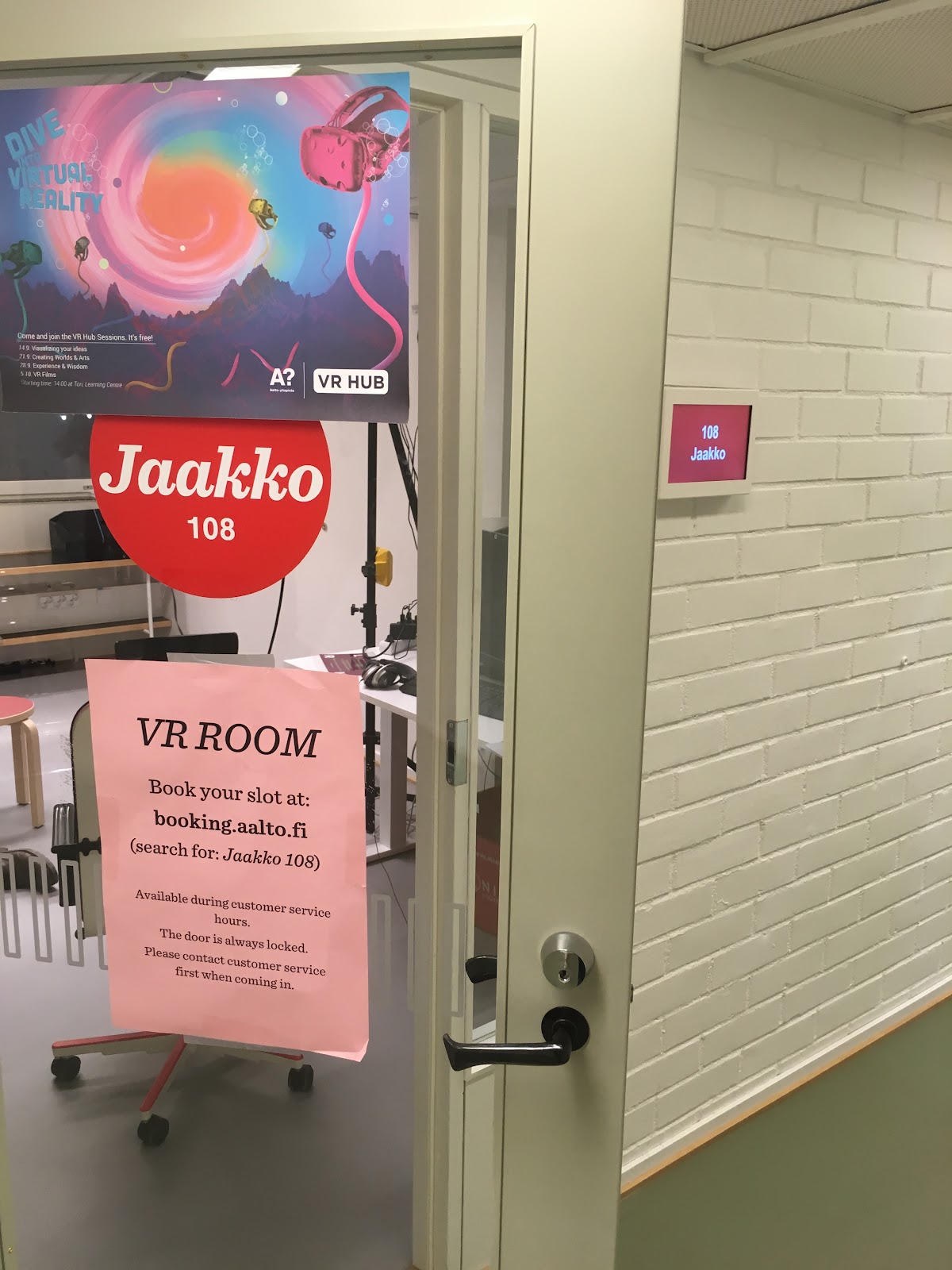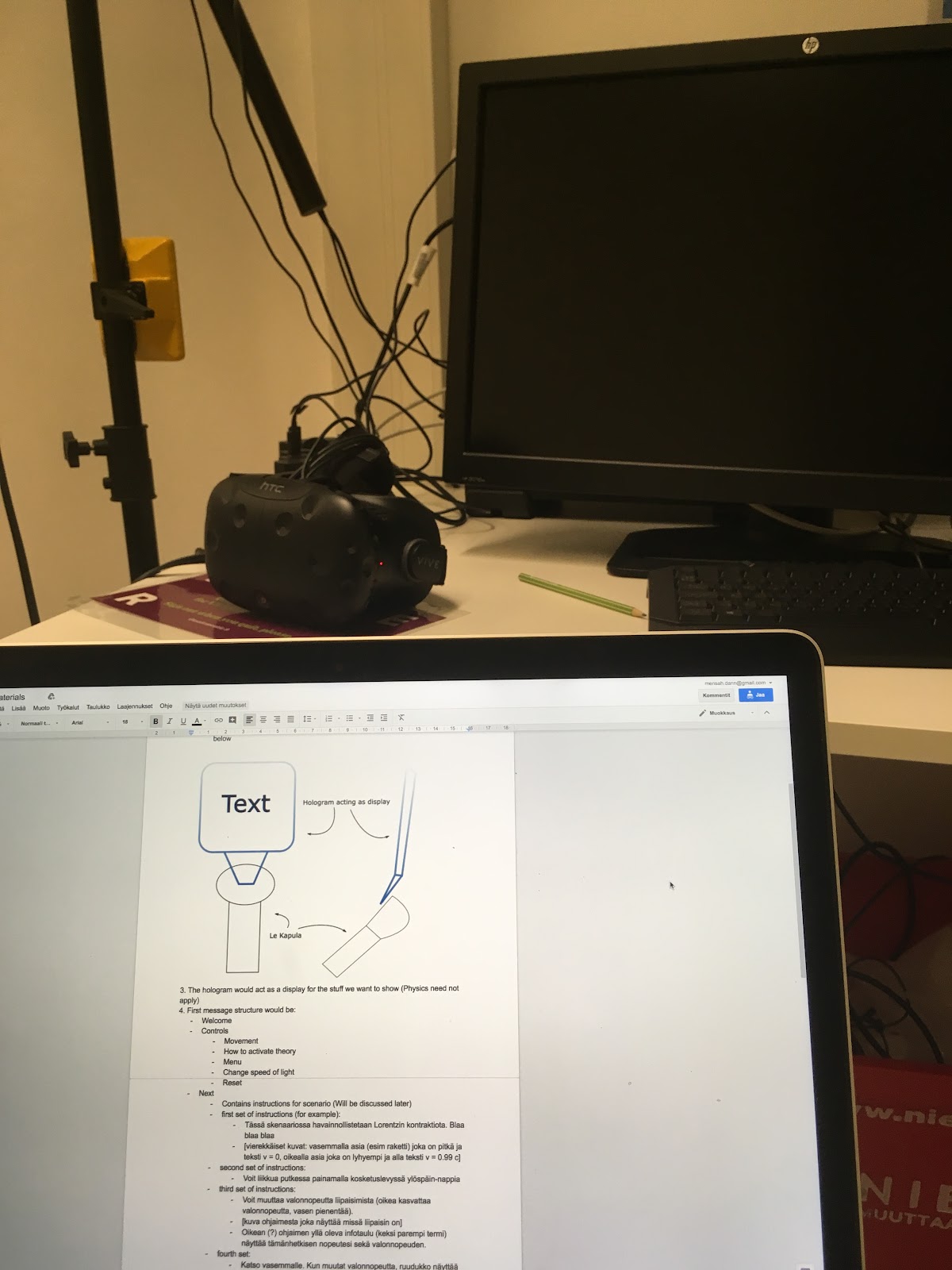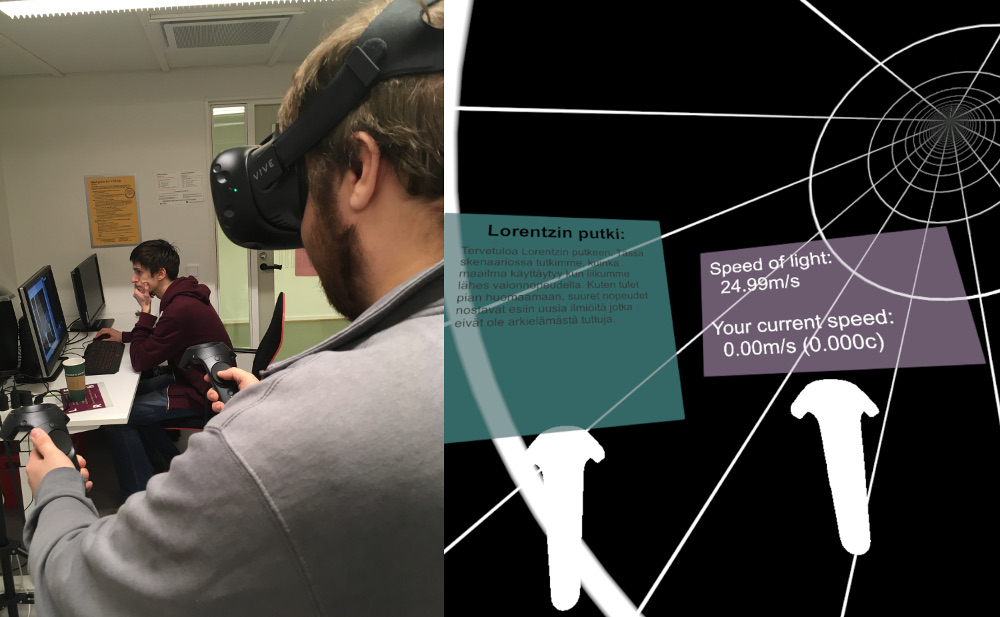Muon Rain and Lorentz Pipe
This week the team's goal was to get a skeleton of the final product done with at least a basic implementation of all the vital features. Previously our feature updates have heavily concentrated on modifying the MIT OpenRelativity project to work in virtual reality with original content being worked on mostly on the side. This week, in contrast, we were fully concentrated on the end-user experience of the product as well as creating the actual educational content. After all, the goal of the project isn't to just show off visually fascinating effects, but to create something that the students can use to understand the actual physical concepts behind the effects.
We also started to take more advantage of Aalto's resources by using their VR lab which is located in the new library. This allowed us to get more space for exploring different VR features and we used the lab to demo our product to our first external tester(!). The tester gave us a lot of ideas on how to further improve our product from the user's standpoint. For example, we'll definitely need to work the flow of things the user experiences from the first moment they put the VR headset on. We also got a lot of tips on how to advance the project from the business side of things and what kind of audience we might want to introduce this to.

At the beginning of this week we finally finished our first map, Lorentz Pipe, was introduced briefly in last week's blog, and the goal of it is to explain what happens when to user moves close to the speed of light.
Since late last week Kristian has been sketching the educational material which will be used to explain the phenomena in Lorentz Pipe. Luckily there is a good amount of information on the web already, but adapting it to an interactive world turned out to be surprisingly challenging.
One of the major challenges Kristian has faced has been to figure out how to merge the educational material to the instructions of Virtual Relativity in a seamless manner, so that once the user pops into the world, they'll instantly know what to do in order to start the learning process. Similarly, introducing the material in an interactive way proved to be quite a daunting task. We didn't want to force-feed all the information to the learner at once, but rather let them explore the possibilities in the simulation and learn in an organic manner by trying out different things. By utilizing methods taught earlier in the course, such as brainstorming and a variant of "forced connections" we finally managed to create what we believe to be a good process of explaining Lorentz contractions in the Lorentz Pipe map.
 Kristian's design of the handheld user interface and structure of the learning process
Kristian's design of the handheld user interface and structure of the learning process
In order to be able to make our product more interesting to the users Tuomas, Dann and Rickard had to overcome a major technical hurdle and get the HTC Vive controllers to work in the Virtual Relativity world.
Before user testing, we had some more time to work with the mapping issues of the controllers. When entering the scene, the controllers were not where they were supposed to be. We needed to find out a way to counteract the unwanted rotation and misalignment. After few hours we managed to find the correct set of parameters for the location and orientation of the controllers.
This enabled us to start working on basic but vital features, such as menus that the user can interact with in the VR world. We also created some interactive educational content, such as pieces of text and images that appear on the user's hand when they reach a new milestone in the learning process and a new concept needs to be explaineed. This also enables us to make the user interface more fascinating to the user, since all the information doesn't have to be attached directly to the user's display and it makes the user experience as a whole much more dynamic.
During the process we came to the conclusion of coloring the controllers white, as previously they were nigh impossible to detect in the almost complete darkness of the scene.

Work on our second map, Muon Rain, has also begun. Our goal with it is to explain how muons, particles that live for a very short time, are able to reach the ground all the way from Earth's atmosphere due to time dilation. We hope to have more info on that in next week's blog!

We also started to take more advantage of Aalto's resources by using their VR lab which is located in the new library. This allowed us to get more space for exploring different VR features and we used the lab to demo our product to our first external tester(!). The tester gave us a lot of ideas on how to further improve our product from the user's standpoint. For example, we'll definitely need to work the flow of things the user experiences from the first moment they put the VR headset on. We also got a lot of tips on how to advance the project from the business side of things and what kind of audience we might want to introduce this to.
Aalto's VR lab
Since late last week Kristian has been sketching the educational material which will be used to explain the phenomena in Lorentz Pipe. Luckily there is a good amount of information on the web already, but adapting it to an interactive world turned out to be surprisingly challenging.
One of the major challenges Kristian has faced has been to figure out how to merge the educational material to the instructions of Virtual Relativity in a seamless manner, so that once the user pops into the world, they'll instantly know what to do in order to start the learning process. Similarly, introducing the material in an interactive way proved to be quite a daunting task. We didn't want to force-feed all the information to the learner at once, but rather let them explore the possibilities in the simulation and learn in an organic manner by trying out different things. By utilizing methods taught earlier in the course, such as brainstorming and a variant of "forced connections" we finally managed to create what we believe to be a good process of explaining Lorentz contractions in the Lorentz Pipe map.
In order to be able to make our product more interesting to the users Tuomas, Dann and Rickard had to overcome a major technical hurdle and get the HTC Vive controllers to work in the Virtual Relativity world.
Before user testing, we had some more time to work with the mapping issues of the controllers. When entering the scene, the controllers were not where they were supposed to be. We needed to find out a way to counteract the unwanted rotation and misalignment. After few hours we managed to find the correct set of parameters for the location and orientation of the controllers.
This enabled us to start working on basic but vital features, such as menus that the user can interact with in the VR world. We also created some interactive educational content, such as pieces of text and images that appear on the user's hand when they reach a new milestone in the learning process and a new concept needs to be explaineed. This also enables us to make the user interface more fascinating to the user, since all the information doesn't have to be attached directly to the user's display and it makes the user experience as a whole much more dynamic.
During the process we came to the conclusion of coloring the controllers white, as previously they were nigh impossible to detect in the almost complete darkness of the scene.
Rickard and Marci testing the now functional controllers in Lorentz Pipe
Work on our second map, Muon Rain, has also begun. Our goal with it is to explain how muons, particles that live for a very short time, are able to reach the ground all the way from Earth's atmosphere due to time dilation. We hope to have more info on that in next week's blog!
Kristian and Tuomas discussing the contents of Muon Rain